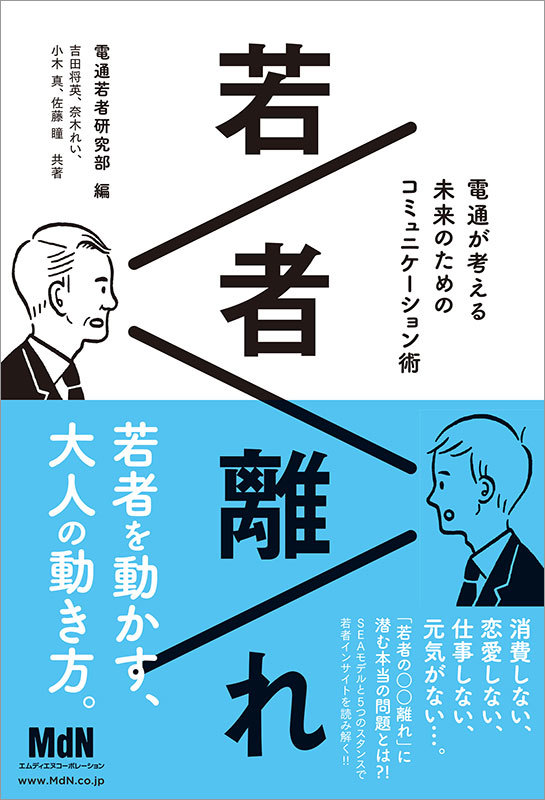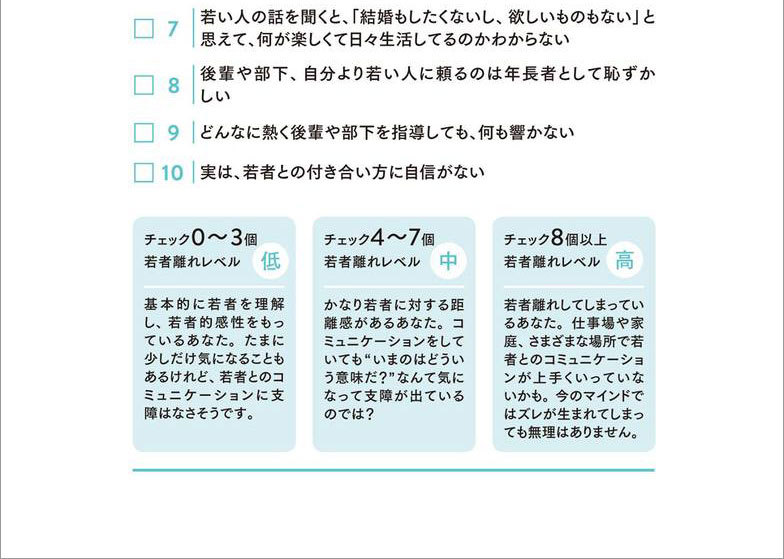Check your "Youth Disengagement Level" right now!
In the book "Disconnecting from Youth," Wakamon created a "Youth Disconnection Checklist."
First, let's check your "Youth Disconnection Level."
As the name suggests, this checklist measures how disconnected you are from young people—how much your values diverge from theirs. As you'll see in the list items, have you ever told young people things like, "Just do it already!" or "That's why young people today..."?
This list actually highlights common behaviors adults tend to exhibit toward young people. What exactly is off-limits? Let's look specifically at two particularly common behaviors.
NG①
Lecturing subordinates or juniors with "This is why young people these days..."
I bet many of you have blurted this out without thinking. The problem with this statement is that it labels young people as a "group." Starting with "These days, young people..." makes them feel, "Ah, this person isn't engaging with me as an individual..." causing them to shut down. You're not engaging with the specific young person in front of you – the "I".
As mentioned last time, whether young people feel validated as individuals is crucial. The presence or absence of this sense of self-affirmation can shape them into either positive powerhouses or vulnerable individuals. That's precisely why, when adults engage with young people, how they approach and nurture that individual "I" becomes even more vital.
The concept of truly engaging with the person in front of you isn't limited to communicating with young people; it's a fundamental approach. Yet, it's surprisingly often neglected in interactions with youth. We must reexamine how we engage with young people. Facing the "individual" rather than the "group" is precisely the ideal adult stance Wakamon envisions.
NG②
Instructions to subordinates or juniors: "Don't ask why, just do it!"
Many bosses and seniors likely say this to young employees.
However, this phrase is also a no-go word you shouldn't say. The background for using this phrase likely stems from personal experience: perhaps they themselves were raised with this approach and felt it led to "actual growth!", or they find "explaining everything in detail a hassle" or "some instructions are hard to put into words..."
It's true that sometimes "Just do it!" makes sense.
But the crucial point here is that today's young people are digital natives, SNS natives—a generation born into an era of information overload. As mentioned before, they possess "the ability to envision businesses and products with original ideas unimaginable to previous generations," meaning they embody "qualitative influence."
Young people are capable of questioning various "assumptions" that were previously taken for granted – such as the idea that older people are always right and superior, or that those with longer work experience are inherently correct – and adopting different approaches and interpretations.
The ideal stance expected of adults is
to engage with them without being bothered
Of course, there's no need to reject past assumptions outright. However, when engaging with them, sharing the "Why" (why, how, for what purpose) becomes a crucial point for gaining their understanding.
In other words, Wakamon believes that sharing the "Why" is extremely important, rather than issuing commands without explanation, and this represents the ideal stance adults should adopt. While explaining the reasons each time might be troublesome, sharing the rationale and significance upfront should dramatically improve the smoothness of subsequent communication.
Wakamon defines this ideal adult stance—neither forcing empathy with youth nor outright rejecting them—as the "Discrepancy Love Stance," meaning embracing the gap with young people.
This time, we've introduced a small part of the ideal adult stance as envisioned by Dentsu Inc. Wakamon using the "Youth Disconnection Checklist." Next time, we'll delve deeper into the "Adults' Stance of Embracing the Gap" and explain why embracing this gap is so important.







